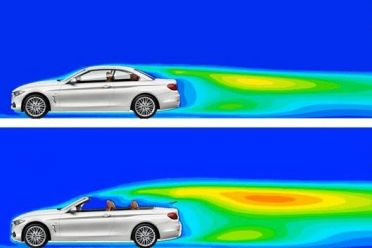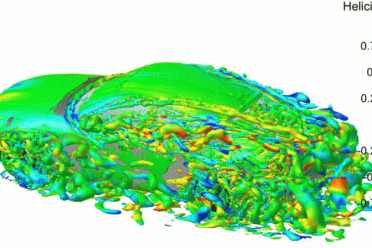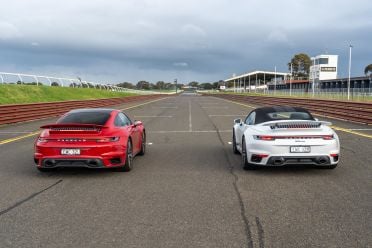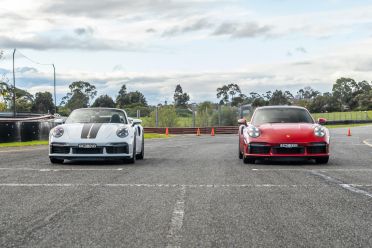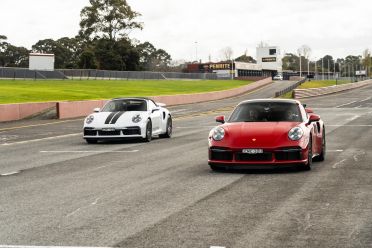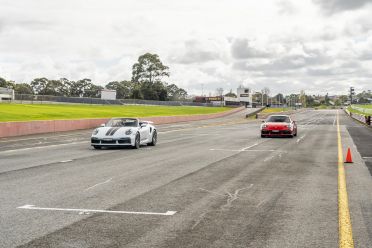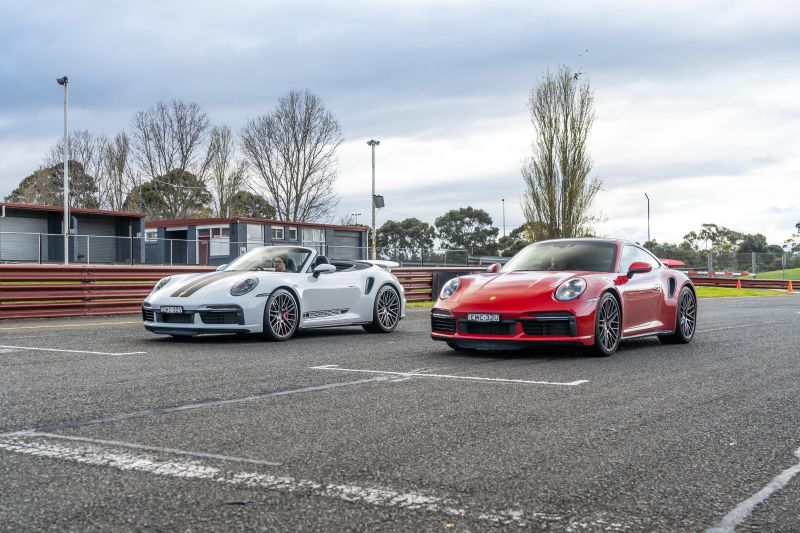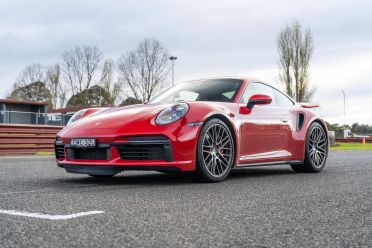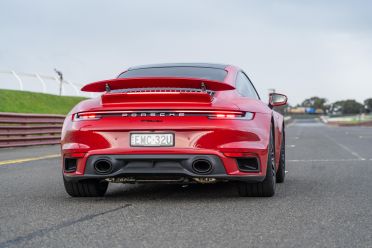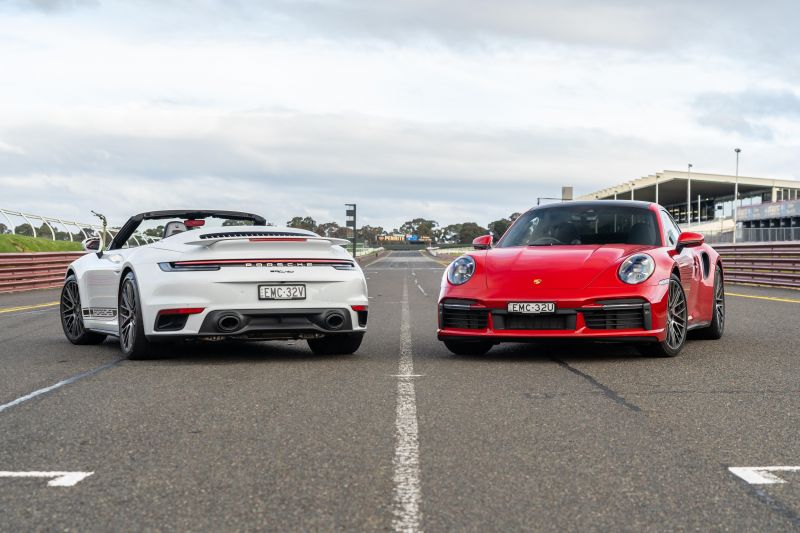One thing that has always intrigued me about convertibles is how much extra power the vehicle needs to make, to overcome wind resistance.
If you extrapolate this further with speed, how much slower is a convertible over a quarter mile when compared to the same version of that car with a fixed roof?
We wanted to put this theory to the test, so we lined up the Porsche 911 Turbo cabriolet against the Porsche 911 Turbo coupe across a number of tests to see how much the open-top was affected by wind turbulence and resistance.
I’m sure you’re all thinking: ‘isn’t there a weight difference between the vehicles?’ Yes. And that’s the reason we ran a number of tests to make sure we accounted for them.
As luck would have it, the track was also damp during periods throughout the day, so we swapped sides to ensure there wasn’t a discernible difference between the two.
The results should be simple, right? That’s what we thought, but it ended up not being so clear cut.
What we wanted to prove
We’re going to get a little nerdy here for a second, but you can compare air flow over a car with water flow over a similar surface. Using Computational Fluid Dynamics (also known as CFD), you’re able to plot flow and more importantly, plot turbulent flow.
Turbulent air flow contributes to turbulent kinetic energy, which ultimately increases resistance. This resistance requires the car to generate more power to achieve the same acceleration as a vehicle without the same level of air resistance.
Removing the roof from a car increases that turbulent air flow because instead of sliding over the smooth surface of the roof and off the back of the vehicle, the open space beyond the windscreen opens a void that creates turbulence and thus extra resistance.
Adding to all of this, there is a weight difference between the two with the convertible weighing more than the coupe. So it not only battles added wind resistance, but it’s forced to carry extra kilos.
We want to prove the theory that removing the roof slows the vehicle down over a quarter mile acceleration run.
The tests
We performed the following tests throughout the day:
- Baseline 1/4 mile run with one passenger per vehicle and roof closed
- Baseline 1/4 mile run with one passenger per vehicle and roof open on convertible
- 1/4 mile run with matched weight and roof closed
- 1/4 mile run with matched weight and roof open on convertible
Each vehicle was equipped with a VBox Sport with an external GPS antenna. Both were configured to include one-foot rollout.
Baseline test results
Run 1 – Baseline 1/4 mile run with one passenger per vehicle and roof closed
| Vehicle | Elapsed Time | 0-100km/h | Terminal Velocity |
|---|---|---|---|
| Turbo Coupe | 11.4s | 3.7s | 206.3km/h |
| Turbo Cabriolet | 11.5s | 3.7s | 207.5km/h |
Run 2 – Baseline 1/4 mile run with one passenger per vehicle and roof open
| Vehicle | Elapsed Time | 0-100km/h | Terminal Velocity |
|---|---|---|---|
| Turbo Coupe | 11.1s | 3.3s | 209.3km/h |
| Turbo Cabriolet | 11.1s | 3.2s | 201.2km/h |
Equal weight test results
For these runs, we wanted to match the weight of both vehicles. Out of the box without any option boxes ticked, there is around 70kg difference between the cabriolet and the coupe. With options fitted to the Coupe it came in at a 60kg weight difference (with the Coupe weighing less).
We put both cars on a calibrated weigh bridge with full tanks of fuel and confirmed the weight difference of around 60kg.
Using this information, we loaded the Coupe up with 20kg of weights, plus an extra passenger. This accounted for the difference in weight between myself and the driver of the cabriolet, plus the fuel load difference between the cars. In theory, they should now weigh around the same.
Run 3 – 1/4 mile run with matched weight and roof closed
| Vehicle | Elapsed Time | 0-100km/h | Terminal Velocity |
|---|---|---|---|
| Turbo Coupe | 10.9s | 3.1s | 207.7km/h |
| Turbo Cabriolet | 10.8s | 3.0s | 211.3km/h |
Run 4 – 1/4 mile run with matched weight and roof open on convertible
| Vehicle | Elapsed Time | 0-100km/h | Terminal Velocity |
|---|---|---|---|
| Turbo Coupe | 11.0s | 3.1s | 206.6km/h |
| Turbo Cabriolet | 10.8s | 2.9s | 208.2km/h |
Run 5 – 1/4 mile run with matched weight and roof open on convertible (swap side of track)
| Vehicle | Elapsed Time | 0-100km/h | Terminal Velocity |
|---|---|---|---|
| Turbo Coupe | 10.8s | 2.9s | 206.5km/h |
| Turbo Cabriolet | 11.1s | 3.2s | 208.1 km/h |
The verdict
Well, I’ve got to admit. We’re pretty confused!
We expected the coupe to walk away from the convertible both before and after we matched weights, let alone when the convertible had the roof stowed.
I think some of the things at play here include:
- While both cars were built in the same factory and were running the same tyres, there’s a chance there were minor differences during the run in procedure or during manufacturing.
- The turbulent area beyond the windscreen is fairly minimal in the 911 compared to something like a C-Class for example, which has a larger area for turbulence to gather. Therefore there may not have been as much wind resistance to overcome.
- Despite using launch control in both cars, there’s a chance there was a difference between the drivers and how they launched each car.
- Wind changes in combination with track temperature and surface grip may have changed during each run affecting how quickly each car covered the quarter mile.
Either way – this was a fun experiment to film. And, if anything, it proves how much of a missile the 911 Turbo is both with and without a roof. It’s truly a phenomenal vehicle.
Let us know in the comments section below whether you have any theories on the results. This test has really confused us!

